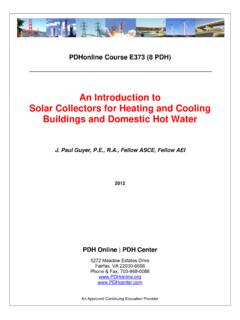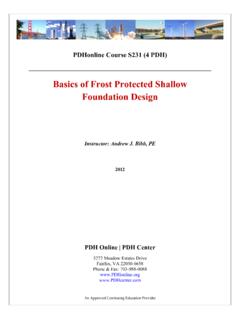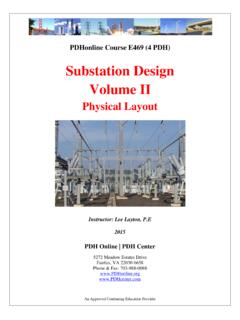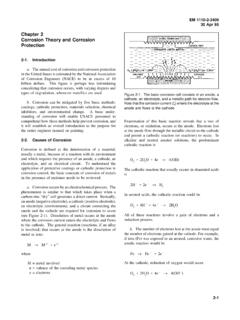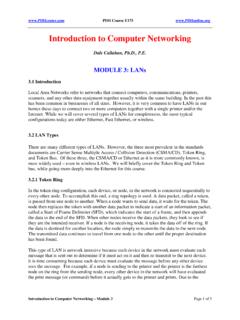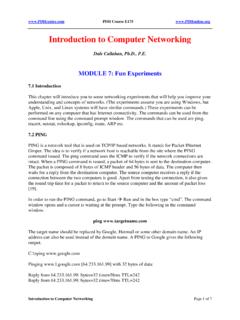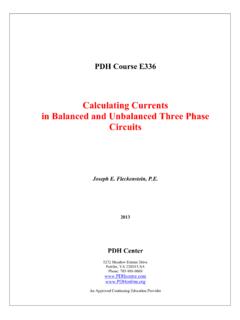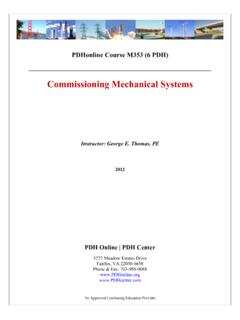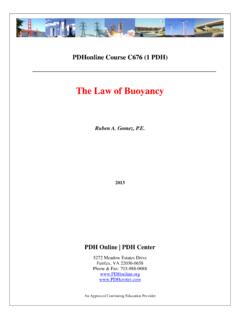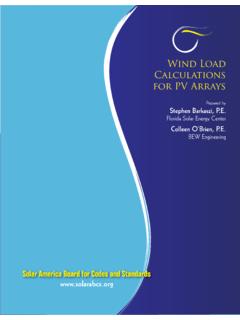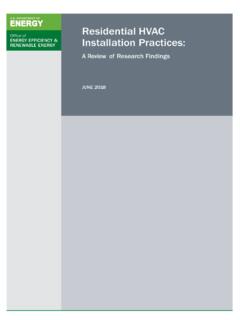Transcription of HVAC & Cooling Towers Practical Calculations
1 An Approved Continuing Education Provider PDHonline Course M 425 (5 PDH) HVAC & Cooling Towers Practical Calculations Instructor: Jurandir Primo, PE 2011 PDH Online | PDH Center 5272 Meadow Estates Drive Fairfax, VA 22030-6658 Phone & Fax: 703-988-0088 PDH Course M 425 2011 Jurandir Primo Page 2 of 74 : CONTENTS - Heat and Temperature - Thermodynamics Basic Concepts Tons of Refrigeration Metabolic Rate Comfort Zone Heat Transfer Dry Bulb Temperature Psychrometrics Concepts Basic Air Conditioning Calculations Heat Loss by Conduction Overall Coefficient of Heat Transmission ( U ) Heat Loss Calculations Heat Conduction and Thermal Resistance - Heat Loss due Air Change (ACH) and Ventilation 15.
2 0 Typical Concrete Frames Thermal Resistance Cooling Load Concepts CLTD/SCL/CLF - Methods of Load Calculations Sizing Ducts - Temperature Loss in Ducts Rules of Thumb for HVAC Calculation Chillers & Air Handling Units (AHU) Chillers and AH Sizing Rules HVAC Refrigerants PDH Course M 425 2011 Jurandir Primo Page 3 of 74 CONTENTS 1. Introduction 2. Cooling Tower Types 3. Components of Cooling Towers 4. Cooling Towers Performances 5. Factors Affecting Cooling Towers Capacity 6. Choosing a Cooling Tower Type 7. Water Flow and Heat Transfer 8. NTU or KaV/L Calculation 9. Consideration of By-Pass Wall Water 10. Pressure Drops in Cooling Towers 11. Air Flow Arrangements 12. Motor Power Sizing 13.
3 Water Evaporation 14. Determination of Pumping Head PDH Course M 425 2011 Jurandir Primo Page 4 of 74 HVAC Practical Calculations : HVAC (pronounced either "H-V-A-C" or, occasionally, "H-vak") is an acronym for Heating, Ventilation and Air Conditioning . HVAC is referred to climate control as a process of treating air to control its temperature, humidity, cleanliness and distribution to meet the requirements of the conditioned space. The HVAC industry had been historically regulated by standards organizations such as ASHRAE, SMACNA, ARI, ACCA, Uniform Mechanical Code, International Building Code, and AMCA established to support the industry and encourage high standards and achievements.
4 The term ventilation is applied to processes that supply air to or remove air from a space by natural or mechanical means. Such air may or may not be conditioned. An air conditioning system has to handle a large variety of energy inputs and outputs in and out of the building where it is used. The basic purpose of an HVAC system is to provide interior thermal conditions that a majority of occupants will find acceptable. Occasionally this may simply require that air be moved at an adequate velocity. However, occupant comfort will require that an HVAC system add or remove heat to or from building spaces. 1. HEAT AND TEMPERATURE: Heat: Heat may be defined as energy in transit from a high-temperature object to a lower-temperature object. This heat transfer may occur by the mechanisms of conduction, convection and radiation. Sensible heat: Kind of heat that increases the temperature of air. It is an expression of the molecular excitation of a given mass of solid, liquid, or gas.
5 Latent heat: Heat that is present in increased moisture of air. It changes the matter from solid to liquid or from liquid to gas. Heat that is required to change solid to liquid is called latent heat of fusion, and that which is required to change liquid to gas is called latent heat of vaporization. Enthalpy: Sum of sensible and latent heat of a substance the air in our environment is actually a mixture air and water vapor. If the enthalpy of air is known, and the enthalpy of desired comfort condition is also known, the difference between them is the enthalpy that must be added (by heating or humidification) or removed (by Cooling or dehumidification). Temperature: A measure of the degree of heat intensity. The temperature difference between two points indicates a potential for heat to move from the warmer point to the colder point. Unit in English system is Fahrenheit, and in International System is Celsius.
6 Dry-bulb temperature (DB): The dry-bulb temperature is the temperature of air measured by a thermometer freely exposed to the air but shielded from radiation and moisture. More specifically, it is a measure of the intensity of kinetic energy of the molecules in the air. It is one of "the most important climate variables for human comfort and building energy efficiency . Wet-bulb temperature (WB): The temperature registered by thermometer whose bulb is covered by a wetted wick and exposed to a current of rapidly moving air. It is the temperature air would have if part of its energy were used to evaporate the amount of water it would absorb to become fully saturated. Dew point temperature: The temperature at which condensation begins when the air is cooled. Relative humidity (RH) = (actual vapor pressure of air-vapor mixture/pressure of water vapor when the air is completely saturated at the same DB temperature) x 100.
7 PDH Course M 425 2011 Jurandir Primo Page 5 of 74 Vapor pressure is the pressure exerted by the motion of molecules of water vapor. It is dependent on the amount of water vapor in the air and the temperature of the air. 2. THERMODYNAMICS BASIC CONCEPTS: The biggest problem in thermodynamics is the student to learn and recognize heat, work, force, energy, power and other technical terms. So to facilitate the basic comprehension of the terms it is very important to remember some concepts below: Cal - The Cal is the standard unit of measurement for heat. The gram calorie, small calorie or calorie (cal) is the amount of energy required to raise the temperature of one gram of water from C to C under standard atmospheric pressure of Kg/cm ( psi).
8 Btu - British Thermal Unit. The Btu is the standard unit of measurement for heat. A Btu is defined as the amount of energy needed to raise the temperature of one pound of water from F to F under standard pressure of 30 inches of mercury ( psi). Energy Unit Conversions: Unit Multiply To obtain 1 Btu kcal 1 Cal Btu 1 kcal 1000 cal Btu Watt is the metric unit for power. Unit Multiply To Obtain 1 W kW hp kcal/s Btu/s ton (refrig) Unit Multiply To Obtain 1 Btu/s ton (refrig) kW hp 1 joule/kilogram/K = J/( ) = 1 joule/kilogram/ C = J/(kg. C) = kilojoule/kilogram/ C = kJ/(kg. C) kilocalorie /kilogram/ C = kcal/(kg. C) Btu/pound/ F = Btu/(lb. F) Btu/pound/ C = Btu/(lb. C) 1 Btu/pound/ F = Btu/(lb F) Btu/pound/ C = Btu/(lb. C) joule/kilogram/ C = J/(kg. C) kilojoule/kilogram/ C = kJ/(kg. C) R PDH Course M 425 2011 Jurandir Primo Page 6 of 74 Obs.
9 : 1 W att-Hour = (Btu/s) x 60 x 60 = Btu/h 1 Btu/h = Watt = kW Celsius (also known as centigrade) is a temperature scale that is named after the Swedish astronomer Anders Celsius (1701 1744), who developed a similar temperature scale two years before his death. Then nominally, 0 C was defined as the freezing point of water and 100 C was defined as the boiling point of water, both at a pressure of one standard atmosphere ( Kg/cm ). Fahrenheit is the temperature scale proposed in 1724 by, and named after, the physicist Daniel Gabriel Fahrenheit (1686 1736). On the Fahrenheit scale, the freezing point of water was 32 degrees Fahrenheit ( F) and the boiling point 212 F at standard atmospheric pressure ( psi). Pressure (P) is the force per unit area applied in a direction perpendicular to the surface of an object. Gauge pressure is the pressure relative to the local atmospheric or ambient pressure. Unit Pascal (Pa) bar (bar) atmosphere (atm) Torr (Torr) pound-force per square inch (psi) 1 Pa 1 N/m 1 bar 100000 106 dyn/cm 750 1 at 98066 1 atm 101325 1 atm 760 1 torr 1 mmHg 1 psi 1 lbf/in 3.
10 TONS OF REFRIGERATION: For commercial and industrial refrigeration systems most of the world uses the kilowatt (kW) as the basic unit refrigeration. Typically, commercial and industrial refrigeration systems are rated in Tons of Refrigeration (TR). One Ton of Refrigeration was defined as the energy removal rate that will freeze 1 ton of water at 0 C (32 F) in one day, or, the amount of heat required to melt 1 ton of ice in 24 hours. The unit's value is approximately 11,958 Btu/h ( kW), redefined to be exactly: 1 Ton of Refrigeration = 12,000 Btu/h ( kW) = 3,024 Kcal/h 4. METABOLIC RATE: Metabolic rate is measured in Met units. A Met is the average amount of heat produced by a sedentary person ( office work = 1 Met). 1 Met unit corresponds approximately: 360 Btu/h = 90,718 cal/h = kcal/h. Human beings are essentially constant-temperature creatures with a normal internal body temperature of F. Heat is produced in the body as result of metabolic activity.
